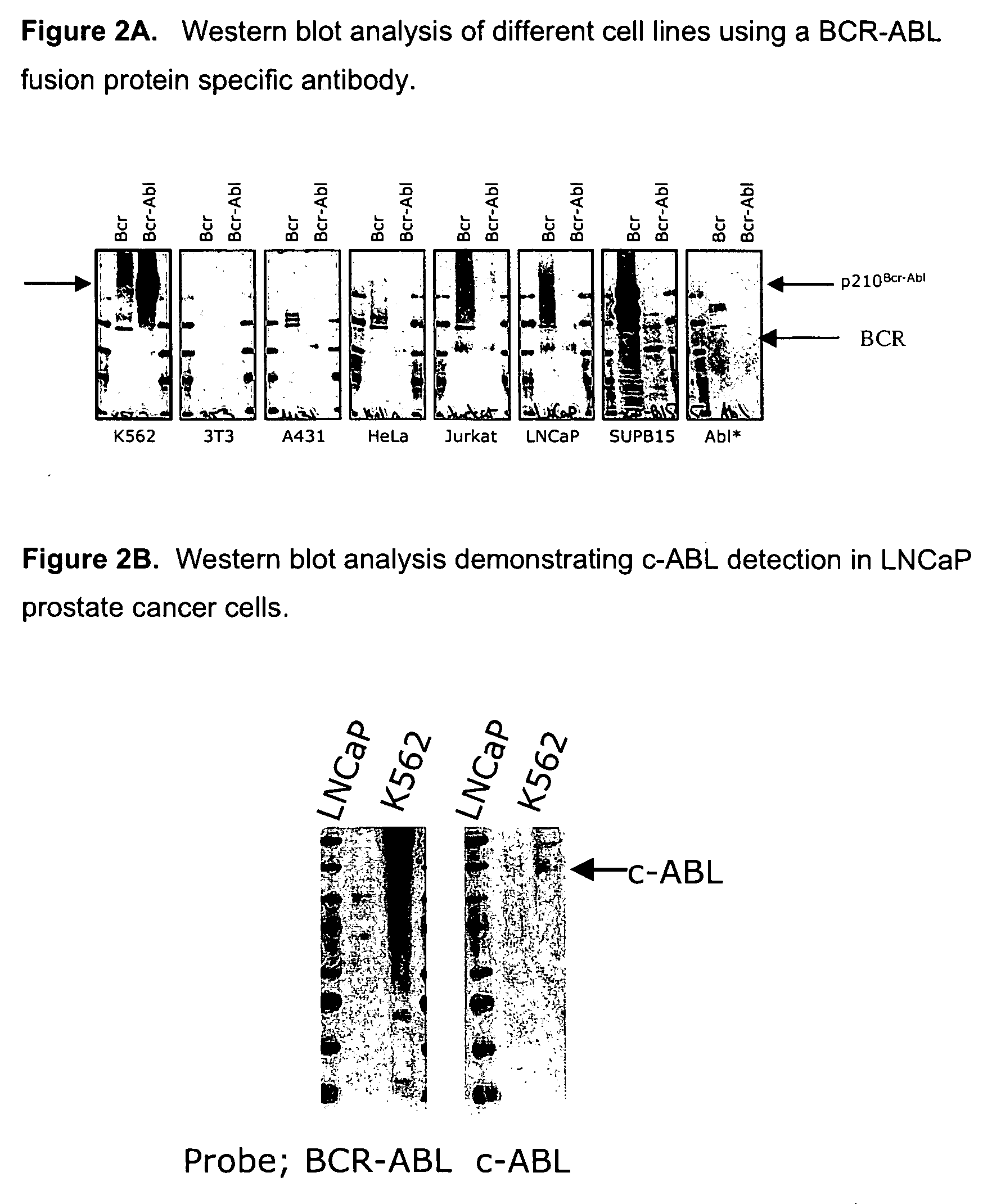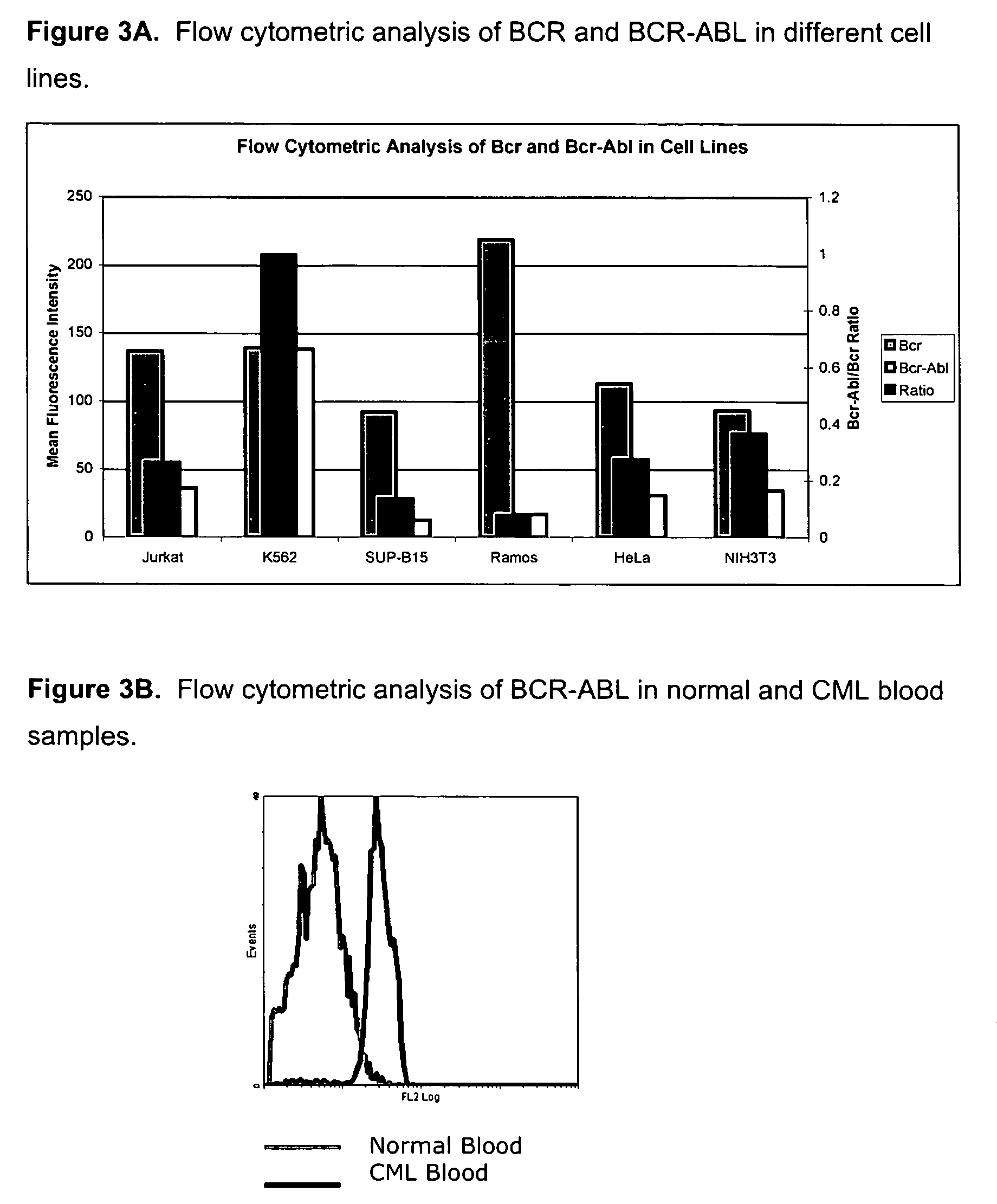Antibodies specific for BCR-ABL fusion protein and uses thereof
a technology of fusion protein and antibody, which is applied in the field of antibodies, can solve the problems of unreliable testing, uncontrolled growth and proliferation of cells, and unreliable labs, and achieve the effects of being expensive, unreliable and unreliabl
- Summary
- Abstract
- Description
- Claims
- Application Information
AI Technical Summary
Problems solved by technology
Method used
Image
Examples
example 1
Production of a BCR-ABL Fusion Protein-Specific Monoclonal Antibody
[0056] A 14 amino acid peptide antigen corresponding to residues spanning the splice region of human P210 BCR-ABL (see residues 94-108 in SEQ ID NO: 1), was constructed according to standard synthesis techniques using a Rainin / Protein Technologies, Inc., Symphony peptide synthesizer. See ANTIBODIES: A LABORATORY MANUAL, supra.; Merrifield, supra. This sequence includes the BCR-ABL splice site at residues 98 / 99, and comprises residues 94-98 (corresponding to BCR wild type residues 897-901) left of the splice site and residues 99-108 (corresponding to c-ABL wild type residues 26-35) right of the splice site. This peptide was coupled to KLH, and BALB / C mice were injected intraperatoneally (IP) with the antigen in complete Freunds adjuvant (500 g antigen per mouse). The mice were boosted with same antigen in incomplete Freund adjuvant (250 g antigen per mouse) every three weeks. After the fifth boost and a further pre-f...
example 2
Western Blot Analysis Using a BCR-ABL Monoclonal Antibody
[0059] The BRC-ABL fusion protein-specific monoclonal antibody (see Example 1) was tested for specificity to the P210 BCR-ABL fusion protein using a Western blot assay. K562, 3T3, Jurkat, HeLa, SUPB15 and 3T3-ABL cell lines were cultured in DMEM or RPMI supplemented with 10% FBS. Of these cell lines, only the K562 cell line has the P210 BCR-ABL translocation. The SUPB15 cell line expresses the P190 BCR-ABL protein. For Western blot analysis, cells were collected, washed with PBS and directly lysed in either cell lysis buffer or denaturing urea buffer. The protein concentration of the cell lysates were measured. The loading buffer was added into cell lysate and the mixture was boiled at 100° C. for 5 minutes. The 15 μl (˜10 μg protein) of sample was added onto 6% SDS-PAGE gel. The standard Western blot was performed according to the Immunoblotting Protocol set out in the Cell Signaling Technology 2002 Catalog and Technical Ref...
example 3
Flow Cytometric Analysis of BCR-ABL Expression Using a BCR-ABL Specific Antibody
[0061] BCR-ABL fusion protein specific monoclonal antibody #4H3 was used in flow cytometry to detect the P210 BCR-ABL protein in k562, Jurkat, Ramos, HeLa, SUPB15 and 3T3 cell lines. Of these cell lines, only the K562 cell line has the P210 BCR-ABL translocation (the SUPB15 cell lines expresses the P190 BCR-ABL protein). Following cell culture as described above, the cells were fixed with 2% paraformaldehyde for 10 minutes at 37° C. followed by cell permeabilization 90% with methanol for 30 minutes on ice. The fixed cells were then stained with the BCR-ABL primary antibody and a BCR primary antibody for 30 minutes at room temperature. The cells were then washed and stained with a FITC-labeled secondary antibody for 30 minutes at room temperature. The cells were then analyzed on a Beckman Coulter FC500 flow cytometer.
[0062] The results of the analysis are presented in FIG. 3A; the white bars represent t...
PUM
| Property | Measurement | Unit |
|---|---|---|
| thick | aaaaa | aaaaa |
| pH | aaaaa | aaaaa |
| resistance | aaaaa | aaaaa |
Abstract
Description
Claims
Application Information
 Login to View More
Login to View More - R&D
- Intellectual Property
- Life Sciences
- Materials
- Tech Scout
- Unparalleled Data Quality
- Higher Quality Content
- 60% Fewer Hallucinations
Browse by: Latest US Patents, China's latest patents, Technical Efficacy Thesaurus, Application Domain, Technology Topic, Popular Technical Reports.
© 2025 PatSnap. All rights reserved.Legal|Privacy policy|Modern Slavery Act Transparency Statement|Sitemap|About US| Contact US: help@patsnap.com



